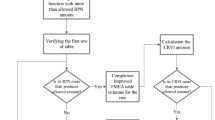Abstract
The efficient control of correct and consistent production information is becoming increasingly difficult due to keener global competition and shortening product life cycles. Total e-business is a solution to the urgent requirement for management and organization changes. Product data management (PDM) is an excellent strategy to introduce e-process and personnel reorganization. However, the performance of introducing the PDM system is usually unsatisfying, due to the impact upon personnel and the product flow. An approach of assessing personnel organization and process failure is proposed in this research in order to locate the factors and reasons that cause a failure for a critical decision reference of enterprises planning for the PDM structure and the product flow. A traditional enterprise that introduced the PDM system was taken as an example in this article to explain the application of the failure mode and effects analysis (FMEA) and quality function deployment (QFD) for an efficient introduction of the PDM system.
Similar content being viewed by others
References
Hauck WC, Anil Bansal PE, Hauck AJ (1997) Simultaneous engineering—correlates of success. Int J Prod Econ 52(1–2):83–90
Ge ZY, Fan WH, Xiong GL, Zhou LS, Li YP, Su XH (2002) Application of PDM base on concurrent engineering. In: Proceedings of the 4th World Congress on Intelligent Control and Automation (WCICA 2002), Shanghai, China, June 2002, vol 4, pp 2604–2607
Kay C, Madden D (1995) Critical success factors in implementing product data management. Int J Microgr Opt Technol 13(4):191–194
The Standish Group (2000) CHAOS 2000 report
Parasuraman A, Zeithaml VA, Berry LL (1991) Understanding customer expectation of service. Sloan Manage Rev 32(3):39–48
Lambert DM, Sharma A (1990) A customer-based competitive analysis for logistics decisions. Int J Phys Distrib Logist Manag 20(1):23
Russomanno DJ, Bommell RD, Bowles JB (1994) Viewing computer-aided failure modes and effects analysis from an artificial intelligence perspective. Integr Comput-Aided Eng 1(3):209–228
Luthra P (1991) FMECA: an integrated approach. In: Proceedings of the 1991 Annual Reliability and Maintainability Symposium, Orlando, Florida, January 1991, pp 235–241
Boyd MA, Abou-Khalil A, Montgomery AT, Gebrael M (1998) Development of automated computer-aided diagnostic systems using FMECA-based knowledge capture methods. In: Proceedings of the 1998 Annual Reliability and Maintainability Symposium, Anaheim, California, January 1998, pp 285–291
Price CJ, Snooke N, Ellis DJ (1999) Identifying design glitches through automated design analysis. In: Proceedings of the 1999 Annual Reliability and Maintainability Symposium, Washington, DC, January 1999, pp 277–282
Kara-Zaitri C, Keller AZ, Barody I, Fleming PV (1992) A smart failure mode and effect analysis package. In: Proceedings of the 1992 Annual Reliability and Maintainability Symposium, Los Angeles, California, January 1982, pp 414–421
IEC 812 Standard (1985) Analysis techniques for system reliability—procedure for failure mode and effects analysis (FMEA)
Pillay A, Wang J (2003) Modified failure mode and effects analysis using approximate reasoning. Reliab Eng Syst Saf 79(1):69–85
Kara-Zaitri C, Fleming PV (1997) Applications of fuzzy inference methods to failure modes effects and criticality analysis (FMECA). In: Proceedings of the International Conference on Safety and Reliability (ESREL’97), Lisbon, Portugal, June 1997, pp 2403–2414
Bowles JB (1998) The new SAE FMECA standard. In: Proceedings of the 1998 Annual Reliability and Maintainability Symposium, Anaheim, California, January 1998, pp 48–53
Raymond MJ (1993) Data flow diagram. System analysis and design—an organizational approach. The Dryden Press, New York, pp 243–252
Gupta UG (1996) Tools for information systems development. Management information systems: a managerial perspective. West Publishing Company, Minneapolis, Minnesota, pp 481–493
Yourdon E, Constantine L (1979) Structured design: fundamentals of a discipline of computer program and systems design. Prentice-Hall, Englewood Cliffs, New Jersey
Juran JM (1951) Quality control handbook. McGraw-Hill, New York
Feigenbaum AV (1961) Quality control: principles, practice, and administration. McGraw-Hill, New York
Lin WT, Chen SC, Chen KS (2005) Evaluation of performance in introducing CE marking on the European market to the machinery industry in Taiwan. Int J Qual Reliab Manage 22(5):503–517
Taguchi G, Elsayed EA, Hsiang TC (2003) Quality engineering in production systems. McGraw-Hill, New York
Nunnally JC (1978) Psychometric theory, 2nd edn. McGraw-Hill, New York
Kay C, Madden D (1995) Critical success factors in implementing product data management. Int J Microgr Opt Technol 13(4):191–194
Stanley (1996) PDM solution: workmanager of HP. Hewlett-Packard South Queensferry Plant, Scotland. CIMdata, pp 37–44
Chris K (2000) Compaq’s collaborative engineering and design. May 2000, pp 1–23
Bossert JL (1990) Quality function deployment: a practitioner’s approach. ASQC Quality Press, Milwaukee, Wisconsin
Koch R (1997) The 80/20 principle: the secret of achieving more with less. Nicholas Brealey Publishing, London, UK
George ML (2002) Lean six sigma. McGraw-Hill, New York, pp 170–177
Author information
Authors and Affiliations
Corresponding author
Rights and permissions
About this article
Cite this article
Chen, S.C., Huang, J.M., Yang, C.C. et al. Failure evaluation and the establishment of an improvement model for product data management introduced to enterprises. Int J Adv Manuf Technol 35, 195–209 (2007). https://doi.org/10.1007/s00170-006-0705-1
Received:
Accepted:
Published:
Issue Date:
DOI: https://doi.org/10.1007/s00170-006-0705-1




